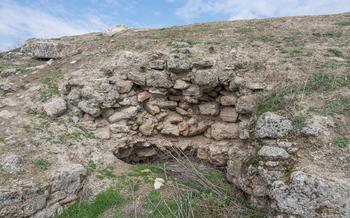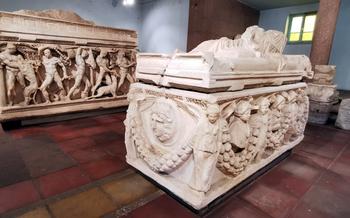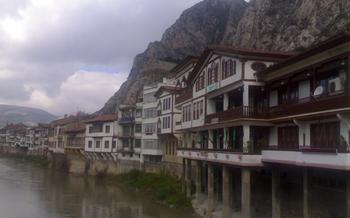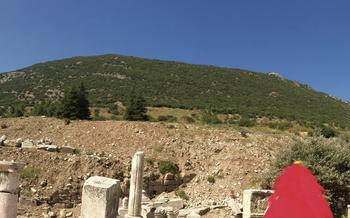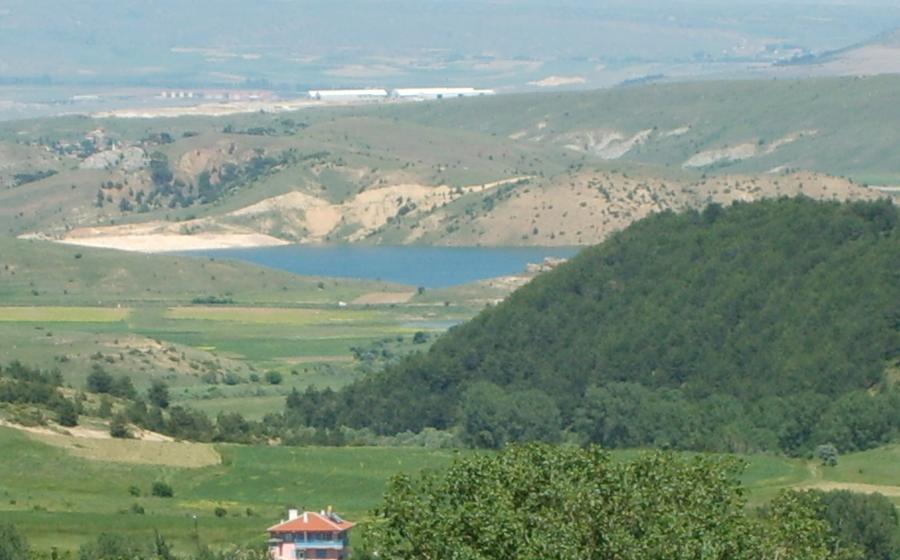
The Rock Tombs of Çankırı
- The Rock Tombs of Çankırı
- Historical Background
- Architecture and Design
- Interior Exploration
- Religious Significance
- UNESCO World Heritage Site
- Admission Fees and Timings
- Exploring the Surroundings
- Photography and Videography
- Accessibility and Facilities
- Respecting Local Customs
- Accommodation and Dining
- Safety and Security
- Insider Tip: Unveiling the Secrets of the Rock Tombs
The Rock Tombs of Çankırı
The Rock Tombs of Çankırı are a testament to the rich history and cultural heritage of this ancient city. Carved into the soft tufa rock that surrounds the city, these tombs date back to the Hellenistic period (3rd century BC) and were used as burial chambers for the city's elite. The tombs are a unique and well-preserved example of rock-cut architecture and offer a glimpse into the lives and beliefs of the people who lived here over two thousand years ago.
The tombs are located on a hill overlooking the city, and their imposing facades are visible from afar. Each tomb consists of a series of chambers, connected by narrow corridors and staircases. The chambers are decorated with intricate carvings and inscriptions, depicting scenes from mythology, religion, and everyday life. The tombs also contain a wealth of artifacts, including jewelry, pottery, and weapons, which provide valuable insights into the culture and customs of the ancient Gangra.
Historical Background
Çankırı, the ancient city of Gangra, has a rich and diverse history, having been influenced by various civilizations throughout the ages. In the 4th century BC, the city was part of the Phrygian kingdom, known for its advanced culture and intricate rock-cut tombs. Later, it fell under the rule of the Hellenistic Seleucid Empire, which introduced Greek influences into the region. The city's strategic location on the trade routes between the Black Sea and Anatolia contributed to its prosperity and cultural exchange. During the Roman period, Gangra became a significant center of Christianity, hosting several church councils and leaving behind a lasting legacy of religious architecture, including the impressive rock tombs.
Architecture and Design
The rock-cut tombs of Çankırı are remarkable examples of ancient funerary architecture. Carved directly into the rocky cliffs, they showcase a blend of Hellenistic and Anatolian influences. The tombs feature intricate facades adorned with various architectural elements, such as columns, pediments, and friezes. The facades often depict scenes from mythology, religious symbolism, and representations of the deceased individuals.
Inside the tombs, visitors will find spacious burial chambers with vaulted ceilings. The chambers are adorned with elaborate carvings, reliefs, and inscriptions. These carvings depict various motifs, including floral patterns, geometric designs, and scenes from daily life. The inscriptions provide valuable insights into the names, titles, and lineages of the individuals buried within the tombs.
A striking feature of the Çankırı tombs is their unique iconography. The carvings and reliefs often incorporate symbolic representations of life, death, and the afterlife. Common motifs include the eagle, symbolizing the soul's journey to the heavens, and the snake, representing the cycle of life and rebirth. These symbols provide a glimpse into the religious beliefs and practices of the ancient inhabitants of the region.
The tombs of Çankırı stand as testaments to the exceptional craftsmanship and artistic skills of the ancient Anatolian artisans. Their architectural features, intricate carvings, and symbolic iconography make them invaluable examples of ancient funerary art and architecture.
Interior Exploration
As you step inside the burial chambers of the Rock Tombs of Çankırı, you are greeted by an atmosphere of reverence and mystery. The dimly lit chambers, hewn from the solid rock, reveal intricate carvings and inscriptions that tell stories of the individuals who were laid to rest here.
The walls are adorned with bas-reliefs depicting scenes from mythology, religious rituals, and everyday life. These carvings provide valuable insights into the beliefs, customs, and artistic traditions of the ancient people who inhabited this region.
Within the tombs, you may also discover artifacts and personal belongings that once belonged to the deceased. These objects, which include jewelry, pottery, and tools, offer tantalizing glimpses into their lives and identities.
By exploring the interior of the Rock Tombs of Çankırı, you gain a deeper understanding of the rich history and culture of this ancient city. Each tomb is a unique and poignant reminder of the lives that were lived and the stories that unfolded within these sacred spaces.
Religious Significance
The Rock Tombs of Çankırı hold profound religious significance, serving as sacred spaces for worship and rituals in ancient times. Evidence unearthed within the tombs reveals intricate carvings and inscriptions that shed light on the religious practices and beliefs of the inhabitants. These symbols and inscriptions provide glimpses into the spiritual realm of the ancient city, offering insights into the religious ceremonies and rituals that took place within the tombs.
Additionally, the tombs' proximity to the ancient city's religious center suggests a strong connection between the two. This proximity implies that the tombs played a vital role in the city's religious life, serving as places of worship and pilgrimage for the community. The tombs may have been used for religious festivals, commemorative ceremonies, or other sacred rituals that brought the community together.
Furthermore, the discovery of Christian symbols and iconography within the tombs hints at the role they played in the development of Christianity in the region. Çankırı was an important center of early Christianity, and the tombs may have served as places of worship or refuge for early Christian communities. The presence of Christian imagery within the tombs suggests that they were not only burial sites but also spaces for religious devotion and community gatherings.
UNESCO World Heritage Site
The Rock Tombs of Çankırı hold exceptional historical and cultural significance, earning their designation as a UNESCO World Heritage Site in 201To be included on this prestigious list, a site must meet specific criteria set by the World Heritage Committee. The tombs fulfill several of these criteria:
-
Outstanding Universal Value (OUV): The tombs exhibit exceptional cultural and historical importance, showcasing unique rock-cut architecture and intricate carvings that provide valuable insights into ancient Anatolian civilizations.
-
Representativeness: The tombs represent a remarkable example of rock-cut architecture, embodying the convergence of Hellenistic and Anatolian artistic traditions. They offer a glimpse into the religious and cultural practices of the region during antiquity.
-
Authenticity and Integrity: The tombs have maintained their authenticity despite the passage of time, preserving their original features and structures. They stand as a testament to the skill and craftsmanship of ancient artisans.
-
Conservation and Management: Turkey has demonstrated its commitment to protecting and preserving the site through ongoing conservation efforts and effective management practices. These measures ensure the long-term preservation of the tombs for future generations.
The inclusion of the Rock Tombs of Çankırı on the UNESCO World Heritage List recognizes their exceptional value as a cultural and historical treasure. It underscores the importance of preserving and protecting this unique site for the benefit of humanity.
Admission Fees and Timings
Visiting the Rock Tombs of Çankırı is a budget-friendly experience. The admission fee is currently set at a nominal rate, making it accessible to travelers of all budgets. To plan your visit, it's essential to be aware of the opening hours and days of operation. The site is generally open to the public from morning until evening, with specific timings varying depending on the season. Guided tours are available for a slightly higher fee and provide an excellent opportunity to delve deeper into the history and significance of the tombs. For those interested in photography enthusiasts, special photography permits may be required, and advance booking is recommended to avoid any inconvenience.
Exploring the Surroundings
Beyond the rock tombs themselves, Çankırı offers a wealth of additional attractions to enrich your visit. The city's historic center is a treasure trove of architectural wonders, with its narrow cobblestone streets lined with traditional Ottoman houses, mosques, and historical landmarks. The Çankırı Museum houses a collection of artifacts and exhibits that shed light on the city's rich past.
Venture beyond the city limits to discover the breathtaking Ilgaz Mountain National Park, a haven for nature enthusiasts. Hike through lush forests, encounter diverse wildlife, and marvel at the stunning views from the park's many peaks. The park also offers opportunities for camping, picnicking, and fishing.
Immerse yourself in the local culture by visiting the vibrant markets, where you can haggle for traditional Turkish handicrafts, spices, and textiles. Savor the flavors of Çankırı's culinary delights, from mouthwatering kebabs to delectable pastries, at the city's many restaurants and cafes.
Whether you seek history, nature, or cultural immersion, Çankırı and its surroundings offer an unforgettable experience for every traveler.
Photography and Videography
The Rock Tombs of Çankırı present a fantastic opportunity for photography enthusiasts and videographers to capture the essence of ancient history and artistic expression. Here are some tips to help you make the most of your visual documentation:
-
Tripod Usage: A tripod is essential for capturing sharp and steady images, especially in low-light conditions within the tombs.
-
Lighting Considerations: Natural light is often limited inside the tombs, so consider using a flashlight or artificial lighting to illuminate the intricate carvings and details.
-
Drone Regulations: Drone photography is generally not permitted within the historical site. Please respect these regulations to avoid disturbing the tranquil atmosphere and ensure the safety of visitors.
-
Respecting Tranquility: Remember that the rock tombs are places of historical and cultural significance. Please be mindful of other visitors and avoid using flash photography or creating loud noises that may disrupt the serenity of the site.
Accessibility and Facilities
The Rock Tombs of Çankırı are committed to ensuring accessibility and inclusivity for all visitors. Wheelchair-accessible routes and parking spaces are available, allowing individuals with disabilities to navigate the site with ease. Restrooms and basic amenities are well-maintained and conveniently located. The site personnel is trained to provide assistance to visitors with disabilities, ensuring a comfortable and enriching experience for everyone.
Respecting Local Customs
When visiting the Rock Tombs of Çankırı, it is essential to be mindful of local customs and traditions to ensure a respectful and enjoyable experience. Here are some guidelines to keep in mind:
-
Dress Code: When visiting religious sites, it is customary to dress modestly. Avoid wearing revealing or overly casual clothing. Opt for lightweight and breathable fabrics suitable for the weather conditions.
-
Noise and Behavior: Maintain a respectful and subdued tone while exploring the tombs. Avoid loud conversations, laughter, or other disruptive behavior that may disturb other visitors or detract from the serene atmosphere of the site.
-
Photography: Before taking photographs of local people, always ask for their permission. Be respectful of their privacy and avoid capturing images that may be considered intrusive or disrespectful.
-
Cultural and Religious Significance: Remember that the Rock Tombs of Çankırı hold deep cultural and religious significance for the local community. Show respect by learning about the history and customs associated with the site and avoiding any actions that may be seen as disrespectful or offensive.
Accommodation and Dining
Çankırı offers a range of accommodation options to suit different budgets and preferences. From cozy guesthouses to modern hotels, visitors can find comfortable lodgings within easy reach of the rock tombs. Immerse yourself in the local culture by opting for a traditional Turkish guesthouse, often run by friendly families who go above and beyond to ensure your stay is memorable.
Indulge in the delectable flavors of Turkish cuisine and savor local specialties like keşkek, a hearty dish made with wheat, meat, and spices. Don't miss the chance to try gözleme, a savory pastry filled with your choice of ingredients. For a unique dining experience, head to one of the charming cafes or restaurants nestled near the rock tombs, offering panoramic views and a delightful ambiance. Whether you prefer a quick bite or a leisurely meal, Çankırı's culinary scene will tantalize your taste buds.
Safety and Security
Exploring the Rock Tombs of Çankırı is generally a safe and enjoyable experience. However, as with any travel destination, it's essential to exercise caution and be aware of your surroundings. Here are some safety tips to keep in mind:
-
Be vigilant and aware of your belongings. While the site is generally safe, petty theft can occur. Keep your valuables close to you and avoid leaving them unattended.
-
Respect local laws and regulations. Turkey has strict laws against drug possession and trafficking. Avoid any involvement with illegal substances.
-
Be mindful of your behavior. The Rock Tombs of Çankırı are a sacred site for many people. Be respectful of local customs and traditions, and avoid loud noises or disruptive behavior.
-
In case of an emergency, dial 1 This is the national emergency number in Turkey, and it will connect you with the nearest police, ambulance, or fire department.
By following these safety tips, you can ensure that your visit to the Rock Tombs of Çankırı is safe and enjoyable.
Insider Tip: Unveiling the Secrets of the Rock Tombs
Apart from the remarkable historical and cultural significance of the Rock Tombs of Çankırı, there are several insider tips that can enhance your visit and offer a unique perspective.
-
Hidden Chamber: Within the intricate network of tunnels and chambers, there's a hidden chamber accessible through a narrow passageway. This secret room often remains unexplored, offering a glimpse into the lesser-known depths of the tombs.
-
Sunrise and Sunset Views: The rock tombs offer a breathtaking backdrop for sunrise and sunset photography. Position yourself strategically to capture the warm hues of the sky illuminating the ancient carvings, creating a magical atmosphere.
-
Local Festivals: Çankırı hosts an annual Rock Tombs Festival during the summer months. This vibrant event celebrates the cultural heritage of the region with traditional music, dance performances, and guided tours, providing an immersive experience.
-
Seasonal Charms: Each season brings a unique charm to the rock tombs. In spring, the surrounding hillsides bloom with colorful wildflowers, while autumn paints the landscape in vibrant hues of red and gold. Winter transforms the tombs into a snowy wonderland, offering a serene and mystical ambiance.


